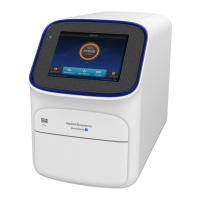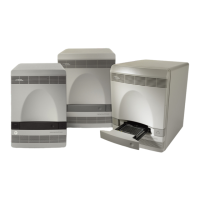within the same lter as their group, but div
erge slightly at other wavelengths (see
below).
Acceptable spectra Unacceptable spectra
Spectra peak at the same wavelength and
do not diverge significantly
Spectra peak at the different wavelengths
Note: Because the w
ells of a calibration plate or array card contain identical
concentrations of a dye, the resulting signals for the wells should be similar.
Variations in spectral position and peak position are caused by minor dierences in
the optical properties and excitation energy between the individual wells.
IMPORTANT! W
ear powder-free gloves and safety glasses when you prepare plates
or array cards.
Prepare the calibration consumable appropriate for your QuantStudio
™
6 or 7 Flex
System:
•
“Prepare the dye calibration plates“ on page 54
• “Preparing array cards for instrument calibration“ on page 37
Required materials to prepare calibration plates
Note: We recommend calibrating with all Spectral Dye Calibrations Plates available
for your block conguration even if you are not using all the dyes in the plates. This is
recommended for optimal system performance.
Table 2 Spectral calibration plates
Block Plate
96-well 0.2-mL block
QuantStudio
™
3/5 Spectr
al Calibration Plate 1
(FAM
™
, VIC
™
, ROX
™
, and SYBR
™
dyes), 96‑Well 0.2‑mL
QuantStudio
™
3/5 Spectral Calibration Plate 2, 96‑Well 0.2‑mL (ABY
™
, JUN
™
, and MUSTANG
PURPLE
™
dyes)
QuantStudio
™
3/5 Spectral Calibration Plate 3, 96‑Well 0.2‑mL
(TAMRA
™
, NED
™
, and Cy
®
5 dyes)
Preparing the
c
alibration plate
or array card
Prepare the dye
c
alibration plates
Chapter 2 Calibr
ate the instrument
Dye calibration
2
54
QuantStudio
™
6 and 7 Flex Real-Time PCR Systems v1.6 Maintenance and Administration Guide

